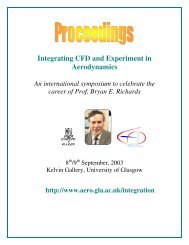Wind-tunnel interference effects on a 70° delta wing - CFD4Aircraft
Wind-tunnel interference effects on a 70° delta wing - CFD4Aircraft
Wind-tunnel interference effects on a 70° delta wing - CFD4Aircraft
You also want an ePaper? Increase the reach of your titles
YUMPU automatically turns print PDFs into web optimized ePapers that Google loves.
NUMBER THE AERONAUTICAL JOURNAL OCTOBER 2004(a) ONERA F2 <str<strong>on</strong>g>tunnel</str<strong>on</strong>g>.Figure 9. Pressure distributi<strong>on</strong>s al<strong>on</strong>g vortex cores.(b) S/W = 0⋅63 <str<strong>on</strong>g>tunnel</str<strong>on</strong>g>Figure 8. Steady flow <str<strong>on</strong>g>tunnel</str<strong>on</strong>g> wall pressure distributi<strong>on</strong>s.changes sign), which are indicated by vertical lines for all threecases. It can be seen that the presence of wind-<str<strong>on</strong>g>tunnel</str<strong>on</strong>g> walls causesthe sec<strong>on</strong>dary separati<strong>on</strong> line to move outboard (i.e. sec<strong>on</strong>dary separati<strong>on</strong>is delayed). The delay in sec<strong>on</strong>dary separati<strong>on</strong> is alsoobserved at the more upstream chordwise locati<strong>on</strong>s, however thevariati<strong>on</strong>s are less apparent. The delay in sec<strong>on</strong>dary separati<strong>on</strong> willbe discussed later. Clearly when the flow is c<strong>on</strong>fined by the ONERAF2 <str<strong>on</strong>g>tunnel</str<strong>on</strong>g>, the primary sucti<strong>on</strong> peak increases, and increases furtheras the side wall proximity becomes nearer the <strong>wing</strong> (the S/W = 0⋅63<str<strong>on</strong>g>tunnel</str<strong>on</strong>g>). It can also be seen that the sec<strong>on</strong>dary vortex increases instrength, almost equally in comparis<strong>on</strong> to the primary sucti<strong>on</strong> peak,with increasing S/W.The <str<strong>on</strong>g>tunnel</str<strong>on</strong>g> wall pressure distributi<strong>on</strong>s <strong>on</strong> the ONERA F2 and theS/W = 0⋅63 <str<strong>on</strong>g>tunnel</str<strong>on</strong>g>s are shown in Fig. 8. The c<strong>on</strong>tour limits for thepressure coefficient plots are –0⋅2 ≤ C p ≤ 0⋅2. It can be see that thereis a str<strong>on</strong>g vortical flow pattern <strong>on</strong> the side walls, which extendsdown the <str<strong>on</strong>g>tunnel</str<strong>on</strong>g> despite vortex breakdown having occurred (thepersistence of vortical flow despite breakdown occurring was alsoobserved during experiments). The flow patterns appear similar forthe ONERA F2 <str<strong>on</strong>g>tunnel</str<strong>on</strong>g> and the S/W = 0⋅63 <str<strong>on</strong>g>tunnel</str<strong>on</strong>g>, however thestrength of the pressure variati<strong>on</strong>s increases with increasing S/W ratio.Given the pressure gradients <strong>on</strong> the <str<strong>on</strong>g>tunnel</str<strong>on</strong>g> side walls, it is clear thereis a significant amount of <str<strong>on</strong>g>interference</str<strong>on</strong>g> induced by the side walls.In order to assess the adverse pressure gradient experienced by thevortex core, the pressure distributi<strong>on</strong> al<strong>on</strong>g the vortex core in each<str<strong>on</strong>g>tunnel</str<strong>on</strong>g> is compared in Fig. 9. Visbal (24) found that vortex breakdownwas heavily dependent <strong>on</strong> the pressure gradient experienced by thevortex core. As the <strong>wing</strong> is placed in a <str<strong>on</strong>g>tunnel</str<strong>on</strong>g> the sucti<strong>on</strong> in thevortex core prior to breakdown increases. This indicates that whenthe vortices are placed within wind-<str<strong>on</strong>g>tunnel</str<strong>on</strong>g>s, they become str<strong>on</strong>gerthan those in farfield c<strong>on</strong>diti<strong>on</strong>s. With this additi<strong>on</strong>al sucti<strong>on</strong> theadverse pressure gradient experienced by the core flow increases,thus vortex breakdown is expected to be promoted. This agrees qualitativelywith the results of Visbal.The flow angle (the angle at which the freestream is turned up dueto the presence of the <strong>wing</strong> and side walls) variati<strong>on</strong> in the streamwisedirecti<strong>on</strong> can be seen in Fig. 10. Both <str<strong>on</strong>g>tunnel</str<strong>on</strong>g>s increase the flowangle ahead of the <strong>wing</strong> in comparis<strong>on</strong> to the farfield soluti<strong>on</strong>, andalso increase the rate at which the flow angle increases al<strong>on</strong>g the<strong>wing</strong>. There are two possible <str<strong>on</strong>g>effects</str<strong>on</strong>g> present, an increase in the meaneffective incidence and induced camber. Both these <str<strong>on</strong>g>effects</str<strong>on</strong>g> increasewith increasing S/W. Since breakdown has moved towards the apexit is expected that the increase in the mean effective incidence is thedominant effect.Figure 11 shows the helix angle variati<strong>on</strong> through the middle(horiz<strong>on</strong>tal line) of the vortex core at the chordwise locati<strong>on</strong> of x/c r =0⋅52. At this chordwise locati<strong>on</strong> the vortex is unburst in all soluti<strong>on</strong>s.The experimental helix angle obtained in the ONERA F2 <str<strong>on</strong>g>tunnel</str<strong>on</strong>g> (19) isalso given for comparis<strong>on</strong>. As the <str<strong>on</strong>g>tunnel</str<strong>on</strong>g> walls get closer to the <strong>wing</strong>it can be seen that the helix angle increases (the turns of the vortextighten), which can cause a promoti<strong>on</strong> of vortex breakdown (25) . Thisis due to the side wall inducing additi<strong>on</strong>al vertical velocity comp<strong>on</strong>ents,which increases the mean effective incidence of the <strong>wing</strong>. Thetightening of the vortex also increases the cross flow momentum.Given that the adverse pressure gradient experienced by the <strong>wing</strong>boundary layer is unchanged as it passes from beneath the primaryvortex core to the sec<strong>on</strong>dary separati<strong>on</strong> regi<strong>on</strong> (since the sec<strong>on</strong>darysucti<strong>on</strong> also increases with the primary sucti<strong>on</strong>), the likely cause ofthe predicted delay in sec<strong>on</strong>dary separati<strong>on</strong> due to <str<strong>on</strong>g>tunnel</str<strong>on</strong>g> walls, is anincrease in cross flow momentum due to the tighter windings of thevortex. It can also be seen that the locati<strong>on</strong> at which the helix anglechanges sign (as we pass through the vortex core) does not appear tomove significantly with increasing S/W ratio, indicating the vortexcore does not move spanwise significantly at this chordwiselocati<strong>on</strong>.
















